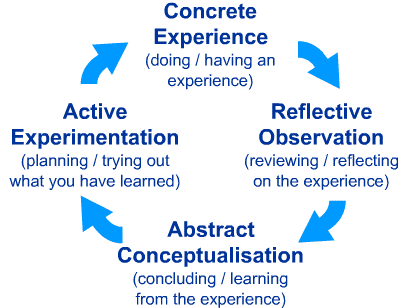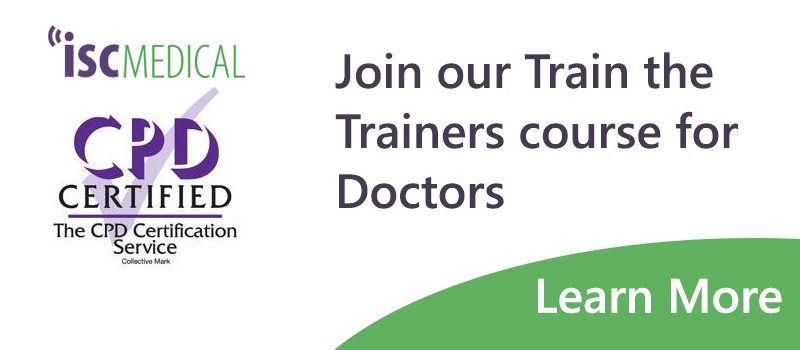The Benefits of Experiential Learning and Kolb’s Learning Cycle for Training
Experiential learning is exactly what the name implies – learning from experience. The experiential approach is learner-centered and allows the individual participants to manage and share responsibility for their learning with their trainer.
Recall and retention
To research the impact of the training style on recall and retention, a group of people were divided randomly into three subgroups each of which were taught something quite simple, the same thing, using three different approaches. The results are shown in the table and it shows how dramatically recall declines when people are only told something.
| Told | Told, shown | Told, shown, experienced | |
| Recall after 3 weeks | 70% | 72% | 85% |
| Recall after 3 months | 10% | 32% | 65% |
Kolb’s Learning Cycle
Kolb developed a theory of experiential learning which gives us a useful model by which to develop training practice. This is called The Kolb Cycle. The cycle comprises four different stages of learning from experience. This can be entered at any point but all stages must be followed in sequence for successful learning to take place.
Effective training strategies which incorporate experiential learning approaches provide opportunities for a person to engage in an activity, review this activity critically, draw some useful insight from the analysis, and apply the result in a practical situation. Remember the poem – I hear and I forget, I see and I remember, I do and I understand.
Kolb’s experiential model can be represented graphically as follows:

The experience (Concrete Experience) phase is the initial activity and data-producing part of the experiential learning cycle. This phase is structured to enable participants to become actively involved in “doing” something. Doing, in this instance, includes a range of activities such as the following:
- Case studies.
- Role plays.
- Simulations.
- Lectures.
- Films and slide shows.
- Skill practice.
- Completing an instrument.
- Games.
This sample list indicates that the range of training techniques varies from the more passive and artificial (lectures) to the more active and real (skill practice). Which technique you choose will depend largely on the goals of the training session.
Once the experience stage is completed, the trainer guides the group into the process (Reflection) part of the cycle. During this phase, participants reflect on the activity undertaken during the experience phase, and share their reactions in a structured way with other members of the group. They may speak individually, in small groups, or as a full training group. They discuss both their intellectual and attitudinal (cognitive and affective) reactions to the activities in which they have engaged. In addition, with the trainer’s assistance, they try to link these thoughts and feelings together in order to derive some meaning from the experience.
The trainer’s role as facilitator is very important during each phase of the cycle. During the process phase, he/she should be prepared to help the participants think critically about the experience and to help them verbalize their feelings and perceptions, as well as draw attention to any recurrent themes or patterns which appear in the participants’ reactions to the experience. The trainer’s role involves helping the participants to conceptualize their reflections on the experience so that they can move towards drawing conclusions.
The generalisation (Abstract Conceptualisation) stage is the part of the experiential learning cycle in which the participants form conclusions and generalizations which might be derived from, or stimulated by the first two phases of the cycle. During this phase, participants are helped to “take a step back” from the immediate experience and discussion, and to think critically in order to draw conclusions that might generally or theoretically apply to “real life.”
This stage is perhaps best symbolized by the following questions:
- What did you learn from all this?
- What more general meaning does this have for you?
The trainer structures this part of the experiential learning model so that the participants work alone first, and then are guided into sharing conclusions with each other, In this way, participants exchange thoughts and ideas so that they may act as catalysts to one another.
The trainer helps to facilitate this step by:
- Asking and helping
individual to summarize what they have learned into concise statements or generalizations - Pushing back at people to help make their thinking more rigorous
- Relating the conclusions reached and integrating them into a theoretical model
- Making sure, within reasonable time boundaries, that everyone who wishes to share a significant insight is given a chance to contribute
- Helping the group compare and contrast different conclusions, identifying patterns where they exist, and identifying legitimate areas of disagreement
After participants have formed some generalizations, they are guided into the application (Active Experimentation)stage of the cycle. Drawing upon insights and conclusions reached during the previous phase (and other phases), they can begin to incorporate what they have learned into their lives by developing plans for more effective behaviour in the future. In an ideal educational or training event, participants would be able to apply what they have learned immediately after the workshop ends. The applications that they plan may relate to their profession or personal life, depending on the background and needs of the specific groups.
Techniques used to facilitate the application stage can include:
- Individual work to develop a thoughtful action plan which puts “thought into action”
- Participants review each other’s plans and assist in formulating ideas for action
- Parts of individual action plans are shared with the whole group in order to create a sense of joint effort
- Additional learning needs are identified by participants
One of the ways the trainer assists during this process is by helping participants be as specific as possible in developing their action plans.
It is important to stress two other points about the experiential learning model. First, the exact nature of each phase of the model is determined by the goals of the training session or program. Once the goals are defined, then the session can be designed using the model as the framework. Second, theory can come in two different places – either before the experience, in which case the experience becomes a way to test the theory or try out the skills implied by it, or after, when it is interwoven into the generalization phase as participants develop their own “theory”.
In order for this model to be effective, it must be rigorously applied, both in the design and delivery stages. “Experiential training is frequently misused in practice where it seems to mean letting people participate in a presentation, having a question and answer session after a lecture, or a role play or case study by itself without the subsequent steps in the model. Most frequently, -the generalizing and application stages are left out of the design of the program. As a result, the power of experiential learning is significantly diminished or is negated altogether.
Although the model, when correctly explained, looks very clear, its practical application is not always as clear. There are transitions between phases, and occasionally (especially if the trainer is going too fast), the group will return to a phase until it is ‘finished’. Also, individuals within the group may not approach the learning process in such a linear fashion, which is perfectly legitimate. The model is meant to serve as a guide for the trainer or instructor who is trying to design and carry out an educational experience for the group.
The model is especially useful for skill training because most of its techniques are active and are designed to involve the participants in skill practice. The experiential model helps people assume responsibility for their own learning because it asks them to reflect on their experience, draw conclusions and identify applications. The effective instructor or trainer does not do this for the participants. Thus, they are not spoon-fed, nor are they led to be dependent on experts. Of course, this model requires a special trainer or instructor style for it to be implemented effectively.
If you want to learn more about different teaching styles, read more on our 2




